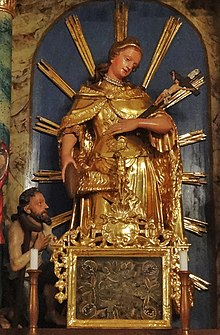Hildegard von Stein
Saint Hildegard von Stein (* around 910; † February 5 , probably 985, in Stein im Jauntal , Carinthia ) is a historically verifiable person who comes from the same Bavarian family as Saint Hemma von Gurk . The exact relationship can no longer be determined, it is only known that both lived around the same time, with Hildegard getting much older. She was also very wealthy.
The relics of Hildegard von Stein rest in the Hildegard altar of the parish church in Stein im Jauntal .
history
According to Wilhelm Wegener , Hildegard was the daughter of Aribo von Leoben from the rich Bavarian Aribone House .
It is known that she was married to Albuin or Alboin or Paul (east of Skarbin he is called Albuin, in the west Paul), Count Palatine of Carinthia (Mon. Car. III 218) and with him at Prosnitza Castle on Skarbiner Felsen Lived over the Drava . There are no more remains of this castle. After the death of her husband, she gave her son Albuin , who later became Bishop of Brixen , the Stein estate in Jauntal around 975 with eight Slavic Huben .
Inculturation and Slovenian Cultural History
The veneration of St. Hildegard von Stein, whose local Slovenian name is Sveta Liharda Kamenska , is a prime example of numerous successive processes of inculturation . On the one hand, elements of the Sicilian St. Agatha , who in turn inculturated the Greco-Roman deities Ceres and Demeter , on the other hand regional pagan Slavic spring cults and finally Christian-Catholic traditions. Its reception up to the present day is closely linked to Slovenian cultural history, as it necessarily required the role of mediator of the Slovene language spoken in the place and in the region, especially since the Jauntal was located in the Slovenian interior for centuries. The Slovenian Liharda song, which originates from the folk song tradition, has been handed down to this day. The Striezel has several autochthonous Slovenian names: Lihardini kržeji , Lihardini štruceji , Agatini kržeji .
The reception, as it was written down in Drobtinice za novo leto by the Slovenian bishop von Lavant Anton Martin Slomšek in 1855, is important for the perpetuation of the Slovenian tradition . In it he describes the holy Hildegard von Stein / Liharda as the "merciful mother of the Slovenes" or as a "Slovenian".
regional customs
Striezel throw in front of the parish church every year on the 1st Sunday in February in honor of St. Hildegard von Stein, Slovenian Liharda.
literature
- Josef Till: 4 K in Stein im Jauntal in the municipality of St. Kanzian am Klopeinersee . Verlag Mohorjeva, Klagenfurt / Ljubljana / Vienna 2009, ISBN 978-3-7086-0400-8 .
- Bojan-Ilija Schnabl: Sveta Liharda kamenska, "Usmiljena mati Slovencev" in njeni podjunski štučeji . In: Nedelja (January 27, 2013) pp. 4–5.
- Bojan-Ilija Schnabl: Sveta Liharda kamenska, "Usmiljena mati Slovencev" in njeni podjunski kržeji . In: Koledar Mohorjeve družbe 2014. Celovec [2013], 48–52.
- Bojan-Ilija Schnabl: Hildegard von Stein . In: Katja Sturm-Schnabl , Bojan-Ilija Schnabl (ed.): Encyclopedia of Slovenian Cultural History in Carinthia / Koroška, from the beginning until 1942 . Vienna-Cologne-Weimar, Böhlau Verlag 2016, Vol. 1, pp. 491–494, ISBN 978-3-205-79673-2 .
Web links
Individual evidence
- ↑ Ankershofen: Kärntner Regesten in AÖG 1848
- ↑ Schnabl, Bojan-Ilija: Sveta Liharda kamenska, "Usmiljena mati Slovencev" in njeni podjunski štučeji. In: Nedelja (January 27, 2013) pp. 4–5.
- ↑ AM Slomšek: Izveličana Lihard, ubogih mila mati, Slovenka . In: Drobtinice za leto 1855. U Celovcu 1855, XI – XV.
| personal data | |
|---|---|
| SURNAME | Hildegard von Stein |
| BRIEF DESCRIPTION | Noblewoman, church founder, saint |
| DATE OF BIRTH | at 910 |
| DATE OF DEATH | February 4th at 985 |
| Place of death | Stein im Jauntal , Carinthia |



